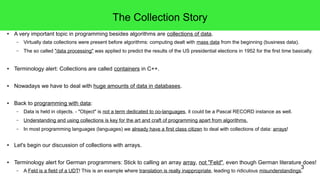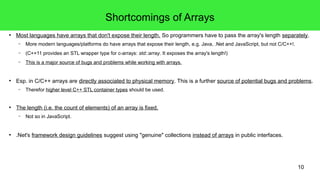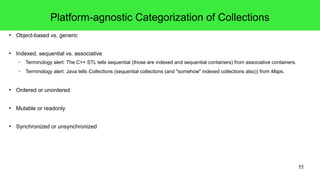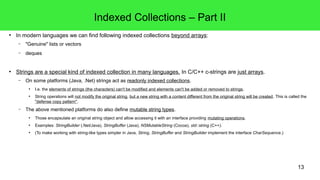The document discusses collections in programming, specifically focusing on arrays and their characteristics across different programming languages. It covers the semantics of data storage (value vs. reference), dimensions of arrays (multidimensional), and various types and categorizations of collections, emphasizing the importance of understanding these concepts for effective programming. Additionally, it points out the limitations of traditional arrays, particularly in C and C++, and introduces alternative collection types such as indexed collections and lists.



![numbers (C/C++)
0 0 0 12 0 numbers2
a sparse array
4
Arrays – Part I
● Generally, we call a collection an array if following statements hold true:
– The collection has the semantics of a table.
– The "rows" of that table, the elements or "slots", can be accessed with a numeric "row number", the so called index.
● Array indexes usually start at 0 (0-based indexing), the index referencing the last element boils down to length – 1. In Basic arrays have 1-based indexing.
– The elements of an array can be accessed randomly with O(1) complexity. - This is very fast!
– (The elements of an array usually have the same static type, C++ calls this the element type.)
● In many languages arrays have integrated syntactical support, e.g. in Java, C++, C#, VB, JavaScript etc.
– Creation of arrays with initializer lists and the []-notation:
// C++
int numbers[] = {1, 2, 3, 4, 5};
// Java
int[] numbers = {1, 2, 3, 4, 5};
int[] numbers2 = new int[5];
● Many languages support an initialization syntax for arrays.
● In C++ automatic arrays require to be created with a constant length known at compile time.
1 2 3 4 5
numbers[0]
numbers[length - 1]
● Other languages like Java and C# create arrays only on the heap, and therefor these languages also accept non-constant lengths for arrays.
– Accessing and manipulating array elements by accessing them with the index/subscript/[]-operator (C++, Java, C#):
// Reading the element at index 3:
int aNumber = numbers[3];
// Writing the value 12 to the element at index 3:
numbers2[3] = 12;
● The array number2 contains only elements of value 0 with the exception of the element at index 3. Arrays having "gaps" are called sparse arrays.](https://image.slidesharecdn.com/2collectionsalgorithms-140902132653-phpapp01/85/2-collections-algorithms-4-320.jpg)
![5
● Support of arrays in various languages:
Arrays – Part II
– Arrays are often the only collection that is integrated into a language, i.e. no extra library imports are required to use them.
● In C/C++ the array elements reside in a contiguous block of memory, which enables the fundamental concept of pointer arithmetics in C/C++
● Therefor C++ requires array elements to be of the same static type because then all elements have the same size to make pointer arithmetics work!
– Arrays have a fixed length (i.e. the count of elements) after creation that can't be changed. - We can not add or remove elements.
● This is not the case for JavaScript arrays. In JavaScript, arrays, also called "array-like objects", are the only type of collections existing!
– Arrays can manage objects of dynamic or static types depending on the support of the language.
● Statically typed languages allow only array elements of the same static type.
● Dynamically typed languages allow individual array elements to be of any type.
– Arrays are a primary construct of imperative languages. In opposite to immutable lists used in functional programming
languages.
1 2 3 4 5
lower address
numbers (C/C++)
higher address
contiguous block of memory
// C++
int numbers[5]; // numbers can only store five ints
Car parkingBay[100]; // parkingBay can only store 100 Car instances
// JavaScript
var objects = [5, "five", {x: 34, y: 4.4}]; // objects contains an integer, a string and an object](https://image.slidesharecdn.com/2collectionsalgorithms-140902132653-phpapp01/85/2-collections-algorithms-5-320.jpg)
![C# - leaving away the type name on creating anonymous
arrays with array initializers
// Assume we have a method with a string-array parameter:
private void AwaitsAStringArray(string[] strings);
// Pass a newly created array with an array initializer:
AwaitsAStringArray(new string[]{ "Monica", "Rebecca", "Lydia" });
// Alternatively leave the type name away on the new keyword:
AwaitsAStringArray(new[]{ "Monica", "Rebecca", "Lydia" });
6 7 jaggedArray (.Net)
6
● Arrays can be n-dimensional (multidimensional) in many programming languages.
– N-dimensional arrays can be used to build matrix data structures.
– 2-dimensional arrays can be seen as an abstraction of tables
having more than one column. 3-dimensional arrays are cubes!
– Terminology alert: sometimes one-dimensional arrays are called vectors! Not to be confused with spatial vectors!
● Languages may support two kinds of n-dimensional arrays:
– Rectangular n-dimensional arrays. Here a 2-dimensional 3x3 matrix (one big object):
// C#
int[,] retangularArray = {{1, 2, 3}, {4, 5, 6}, {7, 8, 9}}; // Represents a 3x3 matrix.
– Jagged n-dimensional arrays are typically build as arrays of arrays (some individual arrays):
// C#
int[][] jaggedArray = new int[3][];
// Set the values of the sub-arrays in the jagged array structure:
jaggedArray[0] = new[] {1, 2, 3, 4};
jaggedArray[1] = new[] {6, 7};
jaggedArray[2] = new[] {8, 9, 0};
1 2 3 4
8 9 0
jaggedArray[0]
jaggedArray[1]
jaggedArray[2]
A=(a11 a12 a13
a21 a22 a23
a31 a32 a33)
rectangularArray=(1 2 3
4 5 6
7 8 9)
Arrays – Part III](https://image.slidesharecdn.com/2collectionsalgorithms-140902132653-phpapp01/85/2-collections-algorithms-6-320.jpg)
![7
Multidimensional Arrays in C/C++
● C/C++ allow the definition of arrays that act like "n-dimensional" arrays.
– "N-dimensional" arrays are equivalent to "normal" arrays in C/C++.
● I. e. the memory layout is equivalent for both. N-dimensional arrays have no genuine concept in C/C++!
– C/C++ provide alternative syntaxes for defining and accessing "mimicked" n-dimensional arrays.
– The definition/initialization syntax differs, however.
● Creation and memory layout:
// Creates an "n-dimensional" 2x3 array in C++:
int mArray[2][3] = {{1, 2, 3}, {4, 5, 6}};
// Creates a "normal" 6 array in C++:
int array[6] = {1, 2, 3, 4, 5, 6};
1 2 3 4 5 6 array
1 2 3 4 5 6 mArray
● The memory layout of C/C++ arrays is done by row-major order, in which the rows are laid down in linear memory after another.
● The elements of multidimensional arrays in C/C++ are accessed with multiple applications of the []-operator:
for (int i = 0; i < 2; ++i) { // 1. "dimension" (columns)
for (int j = 0; j < 3; ++j) { // 2. "dimension" (rows)
mArray[i][j] = 0; // Uses i and j as "coordinates".
}
}
for (int i = 0; i < 6; ++i) {
array[i] = 0; // Uses i as index.
}
● The way C/C++ arrange n-dimensional arrays is critical for optimizations in the CPU's cache and vectorization.
– (But to gain maximum performance, developers have to access elements in a special order.)
– Closely related is the performance gain when using the GPU to process large amounts of data to relief the CPU.
– You should notice that n-dimensional arrays are no topic for application programming, but for high performance computing.](https://image.slidesharecdn.com/2collectionsalgorithms-140902132653-phpapp01/85/2-collections-algorithms-7-320.jpg)
![8
Value and Reference Semantics of Elements
● An important point we've to clarify, is, whether collections hold copies or references to "contained" objects.
– We have to understand, how the language we use handles this.
– Do the collection and the contained elements share the same lifetime or not?
● If a language defines value semantics for contents of variables, arrays will hold copies.
// C++
int value = 42;
42 value
int numbers[5];
numbers[3] = value; // Copies the content of value. ? ? ? 80
42 ? numbers
CCaarr{{ PPoowweerr == 112800 }}
– E.g. an array of int in C/C++:
numbers[3] = 80; // Doesn't modify value.
● If a language defines reference semantics for contents of variables, arrays will hold references.
– E.g. an array of reference type (the class Car in this example) in C#:
C# - automatically implemented properties
public class Car {
// Power's backing field will be created automatically!
public int Power {get; set;}
}
// C#
Car myCar = new Car{ Power = 120 };
Car[] parkingLot = new Car[5];
parkingLot[3] = myCar; // Copy a reference to myCar.
parkingLot[3].Power = 180; // Will also modify myCar!
myCar
null null null null parkingLot
C# - object initializers
// Create a Car object and set the property
// Power:
Car car = new Car();
car.Power = 180;
// Alternatively create a Car object and set
// the property Power within one expression
// as object initializer:
Car car2 = new Car{ Power = 180 };](https://image.slidesharecdn.com/2collectionsalgorithms-140902132653-phpapp01/85/2-collections-algorithms-8-320.jpg)
![9
Homogeneous and Heterogeneous Arrays – dynamic and
static Type of Elements
● Some languages allow holding references to objects as array elements, we can exploit this "layer of indirection".
– E.g. we can create arrays with elements whose static type is the type of a base type and whose dynamic type is any object of
derived type.
● In C++ we can add this extra layer of indirection with pointers to objects of a base type.
– It allows to use the elements of an array polymorphically:
// C++11:
Car car;
Bike bike;
Vehicle* parkingLot[] = {&car, &bike};
for(Vehicle* vehicle : parkingLot) {
vehicle->Drive();
(Bike)
● The array parkingLot holds elements of the static type Vehicle*.
(Car)
parkingLot (Vehicle*[2])
● The pointers can point/indirect to any subtype of Vehicle (in this case Car and Bike).
● Through the pointers held in parkingLot, the overridden method Drive() can be called dynamically.
– The application of polymorphism in arrays (and also other collections) is a very
important feature that is also present in other oo-languages. => It is the basis for
object-based collections.
}/
/ > zooming off...
// > woosh...
// C++:
class Vehicle {
public:
virtual void Drive() const = 0;
};
// C++:
class Car : public Vehicle {
public:
void Drive() const {
std::cout<<"zooming off..."<<std::endl;
}
};
// C++:
class Bike : public Vehicle {
public:
void Drive() const {
std::cout<<"woosh..."<<std::endl;
}
[0] [1] };](https://image.slidesharecdn.com/2collectionsalgorithms-140902132653-phpapp01/85/2-collections-algorithms-9-320.jpg)




![14
Indexed Collections and "Bounds checked Arrays"
● An important shortcoming of arrays in C/C++ is their undefined behavior, if indexes exceed array bounds.
// C++
int numbers[5];
numbers[10] = 10; // Undefined! Above number's bounds.
int value = numbers[-3]; // Undefined! Below number's bounds.
● Modern platforms (Java/.Net) introduce bounds checking of array-access via indexes during run time with exceptions:
// C#:
int numbers = new int[5];
numbers[10] = 10; // Well defined! Will throw ArgumentOutOfRangeException.
// We could also handle ArgumentOutOfRangeException (not recommended):
try
{
int value = numbers[-3]; // Well defined! Will throw ArgumentOutOfRangeException.
}
catch(ArgumentOutOfRangeException)
{
Console.WriteLine("ArgumentOutOfRangeException thrown.");
}
● Indexed collections beyond arrays (e.g. lists) usually support bounds checking with exceptions as well.](https://image.slidesharecdn.com/2collectionsalgorithms-140902132653-phpapp01/85/2-collections-algorithms-14-320.jpg)
![15
● Now its time to introduce our first collection "beyond" arrays: the list.
– Java/.Net provide a implementation of list: ArrayList. ArrayList is an object-based collection, let's understand what that means for us.
● Terminology alert: in Lisp and C++ lists are linked lists and no indexed collections!
● ArrayLists can only store objects of the static .Net type Object! Therefor ArrayList is said to be an object-based collection.
– That's no problem! - The dynamic type stored in ArrayList can be any type derived from Object.
– Each .Net type is derived from Object, therefor any .Net type can be stored in ArrayList as dynamic type.
// C#:
// Create an ArrayList of two elements (passing an int[] to the ctor):
ArrayList aList = new ArrayList(new[]{42, 18});
// 42 and 18 are then stored on the indexes 0 and 1 (ArrayList's index is 0-based).
// When we fetch the values back, we just get objects of the static type Object back:
object the42 = aList[0];
object the18 = aList[1];
// We have to use cast contact lenses to get the dynamic types out of the objects:
int the42AsInt = (int)the42;
// We can also cast directly from the indexer notation:
int the18AsInt = (int)aList[1];
// .Net System.Collections.ArrayList (C#)
public class ArrayList { // (Details hidden)
// The "operator[]":
public object this[int index] {
get { /*pass*/ }
set { /*pass*/ }
}
(int) (int)
● There is just one quirk with object-based collections: we have to use downcasts to get the formerly stored values back!
– This means: we as programmers have to remember the types of the stored values, i.e. their dynamic types!
}
[0] [1]
aList (Object[2])
(logical representation)
Indexed Object-based Collections](https://image.slidesharecdn.com/2collectionsalgorithms-140902132653-phpapp01/85/2-collections-algorithms-15-320.jpg)
![16
● Creating the empty list names:
// C#:
ArrayList names = new ArrayList();
List – Basic Operations
● Then we can add two elements like so:
names.Add("James");
names.Add("Miranda");
C# - collection initializers
// Alternatively create and initialize with a collection
// initializer:
ArrayList names2 = new ArrayList{ "James", "Miranda" };
● We can access the elements of a list like so (bounds checked):
● We can set the elements of a list to new values like so (bounds checked):
● We can get the current count of elements stored in the list:
// Java:
ArrayList names = new ArrayList();
names.add("James");
names.add("Miranda");
// Get the values back (object-based collection):
object name1 = names[0]; // "James" (static type Object)
object name2 = names[1]; // "Miranda"
// Cast the strings out of the objects:
string name1AsString = (string)name1;
// We can also cast directly from the index notation:
string name2As = (string)names[1];
// Get the values back (object-based collection):
Object name1 = names.get(0); // "James" (static type Object)
Object name2 = names.get(1); // "Miranda"
// Cast the strings out of the objects:
String name1AsString = (String)name1;
// We can also cast directly from the getter-call:
String name2As = (String)names.get(1);
names.set(1, "Meredith");
System.out.println(names.get(1));
// >Meredith
names[1] = "Meredith";
Console.WriteLine(names[1]);
// >Meredith
names.add("Christie"); // Adding one more element.
System.out.println(names.size());
// >3
names.Add("Christie"); // Adding one more element.
Console.WriteLine(names.Count);
// >3](https://image.slidesharecdn.com/2collectionsalgorithms-140902132653-phpapp01/85/2-collections-algorithms-16-320.jpg)
![17
List – Other important Operations
● Removing elements (bounds checked):
// Removes the first occurrence of "James" from names.
// - If the specified value is not in the list, nothing will be removed.
names.Remove("James");
// - If the specified index is out of bounds of the list, an
// ArgumentOutOfRangeException will be thrown.
names.RemoveAt(0);
● Inserting elements (bounds checked):
// Inserts "Karl" into names at the specified index.
// - If the specified index is out of bounds of the list, an
// ArgumentOutOfRangeException will be thrown.
names.Insert(0, "Karl");
● Find an element:
// Returns the index where "Karl" resides in names or -1.
int foundIndex = names.IndexOf(value);
● Other operations (selection):
names.Clear();
names.AddRange(new[]{"Mary", "Jane"});
names.Reverse();
// Removes the first occurrence of "James" from names.
// - If the specified value is not in the list, nothing will be removed.
names.remove("James");
// - If the specified index is out of bounds of the list, an
// IndexOutOfBoundsException will be thrown.
names.removeAt(0);
// Inserts "Karl" into names at the specified index.
// - If the specified index is out of bounds of the list, an
// IndexOutOfBoundsException will be thrown.
names.add(0, "Karl");
// Returns the index where "Karl" resides in names or -1.
int foundIndex = names.indexOf(value);
names.clear();
names.addAll(Arrays.asList("Mary", "Jane"));
boolean listIsEmpty = names.isEmpty();](https://image.slidesharecdn.com/2collectionsalgorithms-140902132653-phpapp01/85/2-collections-algorithms-17-320.jpg)
![18
● (Yes, it can be done simpler. This is only an example.)
● We don't know the count of lines in advance: a list seems to be a good collection, because it can grow! Solve it with list!
// C#:
// Begin with an empty list:
ArrayList allLines = new ArrayList();
string line = null;
StreamReader file = new StreamReader("/Library/Logs/Software Update.log");
// Read the file line by line:
while(null != (line = file.ReadLine()))
{
// Add each line to the list as String:
allLines.Add(line);
}
// Output all the read lines to the console:
for (int i = 0; i < allLines.Count; ++i)
{
// As ArrayList is object-based, we've to cast the element back to String:
string storedLine = (string)allLines[i];
Console.WriteLine(storedLine);
}
List – Practical Example:
Reading a File Line by Line into a List](https://image.slidesharecdn.com/2collectionsalgorithms-140902132653-phpapp01/85/2-collections-algorithms-18-320.jpg)
![19
List – Practical Example:
Does the List contain a certain element?
● We could iterate over the list to search a specific entry ("2008-11-24 23:02:24 +0100: Installed "Safari" (3.2.1)"):
bool containsSafari = false;
// Iterate over all entries of the list:
for (int i = 0; i < allLines.Count; ++i)
{
// Find a certain element in the list:
string entry = (string)allLines[i];
if (entry.Equals("2008-11-24 23:02:24 +0100: Installed "Safari" (3.2.1)"))
{
containsSafari = true;
break;
}
}
Console.WriteLine("Contains 'Safari': {0}", containsSafari);
// > Contains 'Safari': True
● Often collections provide more clever operations to check containment of objects directly, e.g. with .Net's method Contains():
– This code does effectively the same as the snippet above, but this time we delegate the search procedure to the list itself!
// Let's ask the list to find the contained element:
bool containsSafari = allLines.Contains("2008-11-24 23:02:24 +0100: Installed "Safari" (3.2.1)");
Console.WriteLine("Contains 'Safari': {0}", containsSafari);
// > Contains 'Safari': True
– As can be seen no loop or comparison is required, list's method Contains() does everything for us!](https://image.slidesharecdn.com/2collectionsalgorithms-140902132653-phpapp01/85/2-collections-algorithms-19-320.jpg)
![20
List – List Comprehensions
● Esp. in functional programming (fp) languages there exist very sophisticated ways to create filled lists w/o loops.
– This is required, because lists can usually not be modified after creation in fp languages. For example in Lisp and Haskell:
– Haskell
numbers = [1..9]
-- >[0, 1, 2, 3, 4, 5, 6, 7, 8, 9]
numbersSquared = [n * n | n <- [0..9]]
-- >[1, 4, 9, 16, 25, 36, 49, 64, 81]
; Common Lisp (loop macro)
(loop for n from 1 to 9 collect n)
; >(1 2 3 4 5 6 7 8 9)
(loop for n from 1 to 9 collect (* n n))
; >(1 4 9 16 25 36 49 64 81)
– What we see here in action is called list comprehension, it means to create collections with complex content in one expression.
● Non-fp languages have been updated to provide list comprehensions in order to get compact expressiveness:
// F#
let numbers = [1..9]
// >[0; 1; 2; 3; 4; 5; 6; 7; 8; 9]
let numbersSquaredList = [ for n in 1 .. 9 -> n * n ]
// > [1; 4; 9; 16; 25; 36; 49; 64; 81]
let numbersSquaredArray = [| for n in 1 .. 9 -> n * n |]
// > [|1; 4; 9; 16; 25; 36; 49; 64; 81|]
// Java (version >= 8 provides streams)
List<Integer> numbers = IntStream.range(1, 10).boxed().collect(Collectors.toList());
List<Integer> numbersSquared = IntStream.range(1, 10)
// C# (version >= 3 provides query expressions)
var numbers = Enumerable.Range(1, 9).ToList();
// > 1, 2, 3, 4, 5, 6, 7, 8, 9
var numbersSquared = (from n in Enumerable.Range(1, 9)
select n * n).ToList();
// > 1, 4, 9, 16, 25, 36, 49, 64, 81
.map(n -> n * n)
.boxed()
.collect(Collectors.toList());
// > 1, 4, 9, 16, 25, 36, 49, 64, 81
// Groovy
def numbers = (1 .. 9).toList()
// >[0; 1; 2; 3; 4; 5; 6; 7; 8; 9]
def numbersSquared = (1 .. 9).collect{it * it}
// >[1, 4, 9, 16, 25, 36, 49, 64, 81]
numbers={n | n∈N, n<10 }
numbersSquared={n2 | n∈N, n<10}
Mathematical set builder notation](https://image.slidesharecdn.com/2collectionsalgorithms-140902132653-phpapp01/85/2-collections-algorithms-20-320.jpg)
![21
Indexed Collections – Size and Capacity – Part I
● When we think about the implementation of an indexed collection we can assume that it is backed by an array.
– This means that indexed collections encapsulate or simulate arrays of varying size. - That's straight forward!
– Now we'll clarify how managing of indexed collections' internal space for contained elements works.
● Most interesting are obviously methods like ArrayList's method add() in Java. It could be implemented like so:
// Java: (fictive implementation of ArrayList.add())
public boolean add(Object element) {
// Enlarge and append:
elementData = Arrays.copyOf(elementData, elementData.length + 1);
elementData[elementData.length - 1] = element;
}
● But the assumed implementation of add() has a serious problem: it is very inefficient!
ArrayList names = new ArrayList(); // Creates an ArrayList of zero elements.
names.add("James"); // Create a new internal array of size one.
names.add("Miranda"); // Create a new internal array of size two.
names.add("Helen"); // Create a new internal array of size three.
– Every time a new element is added two operations are going on basically:
● (1) enlarge: the encapsulated array elementData is copied to a new array having the old length + 1
● (2) append: and then the new element is set as last element in the new array.
ArrayList
- elementData : Object[]
+ add(Object element)](https://image.slidesharecdn.com/2collectionsalgorithms-140902132653-phpapp01/85/2-collections-algorithms-21-320.jpg)
![22
Indexed Collections – Size and Capacity – Part II
● Indeed the real implementation of ArrayList is more clever! ArrayList uses the idea of capacity for more efficiency.
● Let's create another empty ArrayList in Java:
// Java:
ArrayList names = new ArrayList();
– The real representation of names looks not very empty!
● The actual memory representation:
null null null null null null null null null null
elementData (Object[10])
0 size
names (ArrayList)
– As can be seen names is not really empty.
– names' field elementData (this is the encapsulated Object-array) has an initial length of ten.
– All elements of elementData have the initial value null.
– But names exposes a size of zero! - What the heck is going on?
● ArrayList has an initial size of zero and an initial capacity of ten!
– In modern collection APIs, collections maintain capacity and size separately, let's understand why this is a good idea ...](https://image.slidesharecdn.com/2collectionsalgorithms-140902132653-phpapp01/85/2-collections-algorithms-22-320.jpg)
![Indexed Collections – Capacity Control – Part I
● With ArrayList's initial capacity of ten we can add ten elements, before a new elementData-array needs to be created:
"James" "Miranda""Helen""Gil""Trish""Simon""Clark" "Jeff""Sam""Ed"
"James" "Miranda""Helen""Gil""Trish""Simon""Clark" "Jeff""Sam""Ed""Joe"null null null null
23
– Let's begin with adding three Strings to names:
– Add another seven Strings to names:
– Then we add another, the eleventh String to names...
● ...when the capacity of the ArrayList is
exhausted, the encapsulated array
(elementData) needs to be enlarged.
11 size
– (1) A new bigger array is created and
– (2) the content of the old array is copied to the new array.
"James" "Miranda""Helen"
names (ArrayList)
elementData (Object[10])
10 size
elementData (Object[15])
● (In this implementation, elementData is enlarged for five elements, so the new capacity is 15.)
– (3) The last element (the eleventh element) will be set to the added element.
elementData (Object[10])
3 size
names.add("James");
names.add("Miranda");
names.add("Helen");
null null null null null null null
names.addAll(Arrays.asList("Gil", "Trish", "Simon"));
names.addAll(Arrays.asList("Clark", "Jeff", "Sam", "Ed"));
names (ArrayList)
names.add("Joe");
names (ArrayList)](https://image.slidesharecdn.com/2collectionsalgorithms-140902132653-phpapp01/85/2-collections-algorithms-23-320.jpg)
![Indexed Collections – Capacity Control – Part II
● We just learned that when the required space of an ArrayList exceeds its capacity, the internal memory is "re-capacitized".
int initialCapacity = 11; // Ok, we know in advance that we're going to add eleven elements to names. So we can set the required capacity early!
ArrayList names = new ArrayList(initialCapacity); // E.g. we can specify the capacity right in the ctor.
24
● Of course it is! The idea of the encapsulated array's capacity apart from the collection's size is to defer the need to
"re-capacitize" the encapsulated array to the latest thinkable occasion: When size gets greater than capacity.
– But there is a problem: if we constantly exceed the capacity of a collection, it will often be re-capacitized.
● Yes, we can solve this problem with capacity control!
– One idea of capacity control is to set the required capacity of a collection, before elements are added, e.g. like so:
– Add ten elements; the size will be below the capacity:
names.addAll(Arrays.asList("James", "Miranda", "Helen", "Gil", "Trish", "Simon", "Clark", "Jeff", "Sam", "Ed"));
– Then we add the eleventh element...
– ...this just meets the capacity of names
– => With capacity control there was no need for "re-capacitation"!
n"Jualml neusl"l "nMuilrlannudlal n""uHllenleunl"l "nGuilll""nTurilsl hn"u"lSl nimuollnn"ull
elementData (Object[11])
0 size
names (ArrayList)
names.add("Joe");
"Clark" "Jeff""Sam""Ed""nJuolel"
1101](https://image.slidesharecdn.com/2collectionsalgorithms-140902132653-phpapp01/85/2-collections-algorithms-24-320.jpg)
![25
Indexed Collections – Capacity Control – Part III
● Collections (not only indexed collections) often provide a set of methods/properties to manage capacity.
– The capacity is the number of elements a collection can store; the size is the actual number of elements a collection contains.
– => This must always be true: capacity >= size.
● Collections may have ctors to set the initial capacity overriding the default capacity, e.g. initializing it w/ a capacity of eleven:
// Java:
ArrayList names = new ArrayList(11);
names.addAll(Arrays.asList("James", "Miranda", "Helen", "Gil",
"Trish", "Simon", "Clark", "Jeff", "Sam", "Ed", "Joe"));
● Some collections allow setting a certain minimum capacity, or to set the capacity directly:
● But names' size is still eleven!
// C#:
ArrayList names = new ArrayList(11);
names.AddRange(new []{"James", "Miranda", "Helen", "Gil",
"Trish", "Simon", "Clark", "Jeff", "Sam", "Ed", "Joe"});
names.ensureCapacity(20); names.Capacity = 20;
boolean hasEleven = names.size() == 11;
// hasEleven evaluates to true.
bool hasEleven = names.Count == 11;
// hasEleven evaluates to true.
Performance guideline
● If the effective size of a collection to be created is known ahead,
set the capacity as soon as possible, e.g. in the ctor.
● If memory is low, it can be helpful to set a small capacity for a new
collection or to trim the capacity of existing collections to size.](https://image.slidesharecdn.com/2collectionsalgorithms-140902132653-phpapp01/85/2-collections-algorithms-25-320.jpg)
![Indexed Collections – Capacity Control – Part IV
● Collections can also be created along with a bulk of data, which can yield performance benefits due to efficient capacitation:
26
– (Not all platforms apply capacity control on bulk operations!)
// Java; instead of adding items to a list with a loop...
List<Integer> numbers = new ArrayList<>();
for (int item : new int[]{1, 2, 3, 4}) {
numbers.add(item);
● Often collections can also be filled with items in bulk after creation:
}
// … the list could be initialized with another "ad hoc" collection like an array:
List<Integer> numbers2 = new ArrayList<>(Arrays.asList(1, 2, 3, 4));
// C#; instead of adding items to a list with a collection initializer or loop...
IList<int> numbers = new List<int>{1, 2, 3, 4};
IList<int> numbers2 = new List<int>();
foreach (int item in new []{1, 2, 3, 4}) {
numbers2.Add(item);
}
// … the list could be initialized with another "ad hoc" collection like an array:
IList<int> numbers3 = new List<int>(new []{1, 2, 3, 4});
// Java; adding a couple of items to a list in bulk:
List<Integer> numbers = new ArrayList<>();
numbers.addAll(Arrays.asList(1, 2, 3, 4))
// Alternatively Collections.addAll() can be used (its usually faster):
Collections.addAll(numbers, 1, 2, 3, 4);
// C#; adding a couple of items to a list in bulk:
List<int> numbers = new List<int>();
// (Mind that AddRange() isn't available via the interface IList!)
numbers.AddRange(new []{1,2,3,4});](https://image.slidesharecdn.com/2collectionsalgorithms-140902132653-phpapp01/85/2-collections-algorithms-26-320.jpg)
